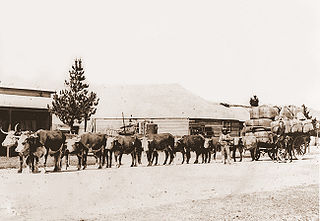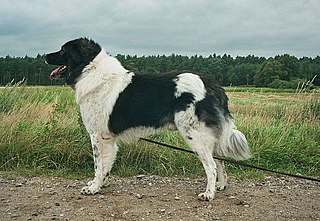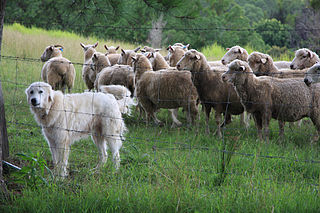
The guard goose is a domestic goose that is used as a guard animal both on farms and in other situations.

The guard goose is a domestic goose that is used as a guard animal both on farms and in other situations.
Geese are considered to have excellent eyesight [1] and to be "watchful and inquisitive", [2] with strong territorial instincts. Goose attacks on humans are commonly reported. One case in 2001 set a legal precedent, resulting in a workers' compensation payout of over $17,000 for an injured delivery person, the first Illinois workers' compensation claim due to wildlife. [3] In another case, several geese protecting their goslings knocked an Englishman off his bicycle resulting in hospitalization. [4] One Buffalo, New York resident claimed over $2 million in damages for a goose attack while on a neighbor's property. At times, park rangers have killed entire flocks of aggressive geese. [5] Canada geese in Cincinnati parks have been responsible for knocking people down and breaking their bones, and called "spitting, hissing, biting attack missiles". [6]
The same aggressive, territorial behavior can be utilized in the guard capacity. Geese are intelligent enough to discern unusual people or sounds from usual stimuli. [7] [8] Their loud honking will alert humans when the geese are alarmed. [1]

Guard geese have been used throughout history, and in modern times. In ancient Rome, geese are credited by the historian Livy for giving the alarm when Gauls invaded (see Battle of the Allia). [9] [10] [11] Geese were subsequently revered in the supplicia canum annual sacrifice, and the Romans later founded a temple to Juno, to whom the geese were considered sacred.
On modern farms, geese are said to be good deterrents to predators of other domestic fowl, [1] [12] and against snakes. A 2006 handbook on industrial security recommends them for protecting warehouses and other isolated physical assets. [13] They are reported to have been used to guard United States Air Defense Command installations in Germany; [14] as the Scotch Watch at Ballantine's Distillery in Dumbarton, Scotland; [15] [16] and to protect a police station in Xinjiang, China. [7] [17] [18]
Due to their tendency to make noise when approached by strangers, about 500 geese were used to supplement dogs, drones, and humans to patrol the 533-km boundary between Chongzuo and Vietnam during the COVID-19 pandemic. An official commented that the birds, one of the most common livestock in the region, are sensitive to sounds and can sometimes be more aggressive than dogs. [19]
A publication by the United States Department of Agriculture lists the African goose, Roman goose (Tufted Roman), Pomeranian goose (Saddleback Pomeranian), and Chinese goose as the best breeds for guard duty. [8] [13] Chinese geese are said to be loud, and African geese both loud and large. [20] [2]

Poultry are domesticated birds kept by humans for the purpose of harvesting useful animal products such as meat, eggs or feathers, and the practice of raising poultry is known as poultry farming. These birds are most typically members of the superorder Galloanserae (fowl), especially the order Galliformes. The term also includes waterfowls of the family Anatidae and other flying birds that are kept and killed for their meat such as the young pigeons, but does not include wild birds hunted for food known as game or quarry.

The greylag goose or graylag goose is a species of large goose in the waterfowl family Anatidae and the type species of the genus Anser. It has mottled and barred grey and white plumage and an orange beak and pink legs. A large bird, it measures between 74 and 91 centimetres in length, with an average weight of 3.3 kilograms. Its distribution is widespread, with birds from the north of its range in Europe and Asia migrating southwards to spend the winter in warmer places. It is the ancestor of most breeds of domestic goose, having been domesticated at least as early as 1360 BCE. The genus name is from anser, the Latin for "goose".

The taiga bean goose is a goose that breeds in northern Europe and Asia. This and the tundra bean goose are recognised as separate species by the American Ornithological Society and the International Ornithologists' Union, but are considered a single species by other authorities. It is migratory and winters further south in Europe and Asia. The taiga and tundra bean goose diverged about 2.5 million years ago and established secondary contact ca. 60,000 years ago, resulting in extensive gene flow.

The Canada goose, sometimes called Canadian goose, is a large wild goose with a black head and neck, white cheeks, white under its chin, and a brown body. It is native to the arctic and temperate regions of North America, and it is occasionally found during migration across the Atlantic in northern Europe. It has been introduced to France, the United Kingdom, Ireland, Finland, Sweden, Denmark, New Zealand, Japan, Chile, Argentina, and the Falkland Islands. Like most geese, the Canada goose is primarily herbivorous and normally migratory; often found on or close to fresh water, the Canada goose is also common in brackish marshes, estuaries, and lagoons.

The Egyptian goose is an African member of the duck family Anatidae. Because of their popularity chiefly as an ornamental bird, the species has also been introduced to Europe, United States and elsewhere outside their natural range. Egyptian geese were considered sacred by the Ancient Egyptians, and appeared in much of their artwork.

The swan goose is a large goose with a natural breeding range in inland Mongolia, Northeast China, and the Russian Far East. It is migratory and winters mainly in central and eastern China. Vagrant birds are encountered in Japan and Korea, and more rarely in Kazakhstan, Laos, coastal Siberia, Taiwan, Thailand and Uzbekistan.

The Chinese is an international breed of domestic goose, known by this name in Europe and in North America. Unlike the majority of goose breeds, it belongs to the knob geese, which derive from Anser cygnoides and are characterised by a prominent basal knob on the upper side of the bill. It originates in China, where there are more than twenty different breeds of knob goose.

A guard dog or watchdog is a dog used to watch for and guard people or property against unwanted or unexpected human or animal intruders.

A working animal is an animal, usually domesticated, that is kept by humans and trained to perform tasks instead of being slaughtered to harvest animal products. Some are used for their physical strength or for transportation, while others are service animals trained to execute certain specialized tasks. They may also be used for milking or herding. Some, at the end of their working lives, may also be used for meat or leather.

A domestic goose is a goose that humans have domesticated and kept for their meat, eggs, or down feathers. Domestic geese have been derived through selective breeding from the wild greylag goose and swan goose.

The wonderful Adventures of Nils is an anime adaptation of the 1906 novel The Wonderful Adventures of Nils by the Swedish author Selma Lagerlöf. The 52 episode series ran on the Japanese network NHK from January 1980 to March 1981. The series was the first production by Pierrot. The anime was mostly true to the original, apart from the appearance of Nils's pet hamster, and the larger role given to Smirre the fox. The music was written by Czech composer Karel Svoboda; Yukihide Takekawa provided the soundtrack for its original Japanese broadcast and for some other countries.

The Karakachan dog is a breed that originated from Bulgaria. It is related to the livestock guardian dogs of the surrounding countries: Romania to the north, North Macedonia and Serbia to the west, and Greece, and Turkey to the south. The dog is named after the Karakachans, Greek nomadic shepherds. Due to their conservative stock-breeding traditions, they have preserved some of the oldest breeds of domestic animals in Europe: the Karakachan sheep, Karakachan horse and the Karakachan dog.

A livestock guardian dog (LGD) is a dog type bred for the purpose of protecting livestock from predators.

Pilgrim geese is a breed of domestic goose. They are considered to be a relatively quiet, lightweight and medium-sized breed. The pilgrim goose is a rare and critically endangered species according to the American Livestock Breeds Conservancy (ALBC) and was officially entered into the American Poultry Association's Standard of Perfection in 1939. Generally, they can live for 15 to 25 years. In most breeds of geese, males and females are indistinguishable from one another; however, the pilgrim goose is well known for its auto-sexing trait. Males are characterised by white feathers while the females have grey. This sexual dimorphism makes pilgrim geese desirable for breeding as the sexes are easily determined. Their commercial use is primarily limited to the United States where they are bred for eggs and meat. They are known to grow relatively fast and are easy to handle.

Sheep or domestic sheep are a domesticated, ruminant mammal typically kept as livestock. Although the term sheep can apply to other species in the genus Ovis, in everyday usage it almost always refers to domesticated sheep. Like all ruminants, sheep are members of the order Artiodactyla, the even-toed ungulates. Numbering a little over one billion, domestic sheep are also the most numerous species of sheep. An adult female is referred to as a ewe, an intact male as a ram, occasionally a tup, a castrated male as a wether, and a young sheep as a lamb.

The Buckeye is an American breed of chicken. It was created in Ohio in the late nineteenth century by Nettie Metcalf. The color of its plumage was intended to resemble the color of the seeds of Aesculus glabra, the Ohio Buckeye plant for which the state is called the 'Buckeye State'.

The Pomeranian goose, also known as the Rügener goose, is a breed of domestic goose.
Contact calls are seemingly haphazard sounds made by many social animals. Contact calls are unlike other calls in that they are not usually widely used, conspicuous calls, but rather short exclamations that differ between individuals. Often, the message that the call is meant to convey is specific to the individual or group's activity, such as informing other members of the group about one's location while foraging for food. Some social animal species communicate the signal of potential danger by stopping contact calls, without the use of alarm calls. Charles Darwin wrote about this in relation to wild horse and cattle.

The bean goose is a goose that breeds in northern Europe and Eurosiberia. It has two distinct varieties, one inhabiting taiga habitats and one inhabiting tundra. These are recognised as separate species by the American Ornithologists' Union and the IOC, but are considered a single species by other authorities, such as the British Ornithologists' Union. It is migratory and winters further south in Europe and Asia.

Nettie Metcalf was an American farmer from Warren, Ohio. She is best known for creating the Buckeye chicken breed, which was officiated by the American Poultry Association in February 1905. Metcalf attended poultry meetings across North America and became President of the American Buckeye Club. She is the only woman recorded by the American Poultry Association to create a chicken breed.
Canada geese appear majestic and serene...the next moment they become spitting, hissing, biting attack missiles, knocking people to the ground, breaking bones and opening head wounds ... threatening to overtake every available waterway in Southwestern Ohio - are dominating public parks and golf courses, spreading diseases and attacking humans at an alarming rate.
gaggles of geese will soon begin guard duty at American military installations in West Germany. Eventually, 900...will take up posts at 30 sites run by the U.S. Army's 32nd Air Defense Command.